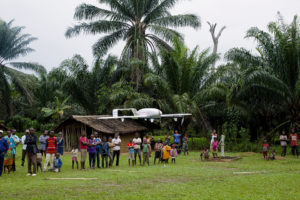
If the current pandemic has created “a moment” for unmanned technology, where are all the drones? It’s not that simple, say humanitarians.
The following is a guest post co-authored by Olivier Defawe, Director of the VillageReach Drones for Health Program, and David Sarley, Innovation and Supply Chain Director at the Gates Foundation. DRONELIFE is honored to publish this original op-ed: DRONELIFE neither accepts nor makes any payment for guest posts.
The headlines are everywhere—there is a game changer in the fight against COVID-19. Drones are on their way to deliver samples and airdrop personal protective equipment (PPE), and are even flying overhead to enforce stay-at-home orders and social distancing. With all the hype, you would think drones are as ubiquitous as birds in the sky.
COVID-19 is also pushing governments all over the world to think differently about the health care system and many are writing the playbook as they go. It is a medical emergency of epic proportions— one that requires resilient supply chains to deliver critically needed supplies, but at the same time minimizing human contact. It seems like now would be the perfect moment for drone delivery to take flight. Yet scaled medical drone delivery examples remain few and far between.
The truth is that drones for medical delivery depend on long-term investments in systems that needed to start years before this pandemic. So what can we learn?
Taking flight isn’t as simple as ready-set-go
At the most basic level, drone integration into the health system requires the buy-in and commitment of government agencies. Without this, even the most rudimentary of operations cannot take off. Critical to operations is the identification of reliable and affordable drones; this requires vetting manufacturers and developing relationships to ensure the best partnership right from the start. From obtaining regulatory approvals to fly beyond visual line of site, to setting flight paths, and identifying qualified pilots to operate the drones – all this needs to happen long before a drone can take flight. At minimum, it can take months to build and launch a drone operation from scratch, and this is if all of the pieces fall into place quickly.
Currently, there are less than a dozen companies globally that have cargo drones that can reliably carry the payloads over distances needed for medical delivery. With air, ship and freight services disrupted and borders closed to international travel, it is near to impossible to get the drones and the operators trained in country and the network set-up if they aren’t already in place. Simply put, there are too many hurdles to get over in today’s complicated environment.
Ghana and Malawi put systems in place
In sub-Saharan Africa, drones have long been seen as a way to transform supply chains and leapfrog physical infrastructure constraints to get products to people more quickly. Ghana and Malawi are two countries that recognized this and started operating drones for medical delivery long before the crisis happened. Now they have pivoted their drones operations quickly to support COVID-19 response efforts.
In 2018, the government of Ghana started developing the enabling environment for medical drone delivery. Everything from building a public-private partnership with Zipline, developing appropriate regulations, obtaining parliamentary approval and building drone infrastructure. The following year, Zipline began to deliver vaccines, blood and essential medicines to over 2000 public health facilities. When COVID-19 hit, they were able to integrate readiness and response items, including lab samples, into their drone delivery network.
Malawi has been a global hub since 2016 with its Malawi Humanitarian Drone Corridor and African Drone and Data Academy. This is largely due to the government’s appetite for innovation and its regulatory leadership.
Beginning in January 2020, the Malawian government, in partnership with UKAID and UNICEF, began integrating medical drone deliveries into two districts in Southern Malawi utilizing drone logistics services by Swoop Aero. Three months later, Swoop Aero became the first drone logistics company with an ‘outside of the country’ operation, due to its international pilots’ need to leave Malawi as a result of the pandemic. Since then, the system has continued operating and has consistently delivered COVID-19 products to remote health facilities.
The ways drones are used and the investments made are different, but Ghana and Malawi share similar success factors:
They defined agile regulatory and approval processes that encouraged innovation and prioritized safety. This allowed regulators to work quickly with the drone operators to approve the new operations to fight the pandemic. In Ghana, it included opening up a no-fly zone to Zipline so drones could deliver samples to the national testing facility. In Malawi, it meant allowing drones to be piloted by Swoop Aero in Australia.
They invested in a local workforce to run drone operations. Although Zipline and Swoop Aero are international companies, day-to-day operations are managed locally. The skilled workers were already on the ground and operating, so when COVID-19 struck they did not have to stop operations.
In search of a new investment paradigm
Without a doubt, governments want to add drones to their fleet of delivery options and drone services providers are yearning to meet their requests. But while supply and demand exist, market failure keeps investors gun-shy. The risk for government is high while revenue streams are uncertain for suppliers. In order to reconcile the two, a new investment paradigm is needed where all the actors are willing to take a gamble.
Venture capital firms typically focus on funding start-ups in higher-return markets than low- and middle-income countries (LMICs). Suppliers do not necessarily have the capital from patient investors willing to wager on the development of a service offering. Donors, like bi- and multi-lateral funders and foundations, have kept their eyes on boutique pilot projects without a longer-term vision and have failed to fund long-term deployments. We still see this in Malawi, where drones have been successfully flying on and off for the past five years. However, financing is fragmented and no deployments have lasted longer than seven months.
On the other hand, Ghana was willing to take a gamble, and one of its keys to success was the investment in strategic commercial and public-private partnerships.
Private sector, donors and NGOs can help governments “de-risk” new technologies to accelerate their introduction. Yet, too often minimizing risk prevails, outweighing or at least delaying the potential value of such technologies to meet real needs. This combined with complicated contracting and procurement models has created market failure. For example, if governments follow World Bank procedures, contracts can take two years to be realized.
But models do exist in the health care sector for innovative financing mechanisms, which appropriately leverage both public and private dollars, are designed for LMICs, and allow the time needed to build the operating environment and regulatory structures. A new market shaping opportunity that leverages private sector for early stage and donor funding for later stage investments that both de-risk and enable greater uptake just might be the ticket.
Medical drone delivery, and drone delivery in general, still has a ways to go. While there are a growing number of deployments, such as in Canada, India, UK and USA, there still is more pioneering to be done. We can see clearly now that we did not have systems in place to handle a medical emergency of this magnitude. But there is still time to get systems in place for when the COVID-19 vaccine comes. While we are many months out, will more countries be ready? That is the million dollar question.
 Olivier Defawe is Director Health Systems at VillageReach. Defawe has been the Drones for Health program lead since its inception in 2015. He oversees the organization’s portfolio with stakeholders across Democratic of Congo (DRC), Malawi and Mozambique to explore and implement medical drone delivery solutions in health systems. He also the founder of the UAV for payload delivery working group focused on the advancement and application of UAV for public health and supply chain improvement through the coordination of evidence generation and experience among partners and stakeholders. Defawe holds a PhD in Biomedical sciences.
Olivier Defawe is Director Health Systems at VillageReach. Defawe has been the Drones for Health program lead since its inception in 2015. He oversees the organization’s portfolio with stakeholders across Democratic of Congo (DRC), Malawi and Mozambique to explore and implement medical drone delivery solutions in health systems. He also the founder of the UAV for payload delivery working group focused on the advancement and application of UAV for public health and supply chain improvement through the coordination of evidence generation and experience among partners and stakeholders. Defawe holds a PhD in Biomedical sciences.
 David Sarley is Senior Program Officer at The Bill and Melinda Gates Foundation. Sarley is focused on impact investing to strengthen primary health care to reduce under five and maternal mortality. He also manages Grand Challenges Exploration for the Global Delivery Program. His current investments include in Zipline, Macro-Eyes, VillageReach, PATH and the William Davidson Institute.
David Sarley is Senior Program Officer at The Bill and Melinda Gates Foundation. Sarley is focused on impact investing to strengthen primary health care to reduce under five and maternal mortality. He also manages Grand Challenges Exploration for the Global Delivery Program. His current investments include in Zipline, Macro-Eyes, VillageReach, PATH and the William Davidson Institute.
Miriam McNabb is the Editor-in-Chief of DRONELIFE and CEO of JobForDrones, a professional drone services marketplace, and a fascinated observer of the emerging drone industry and the regulatory environment for drones. Miriam has penned over 3,000 articles focused on the commercial drone space and is an international speaker and recognized figure in the industry. Miriam has a degree from the University of Chicago and over 20 years of experience in high tech sales and marketing for new technologies.
For drone industry consulting or writing, Email Miriam.
TWITTER:@spaldingbarker
Subscribe to DroneLife here.







[…] Read more from Olivier Defawe in an earlier DRONELIFE Op-Ed: COVID-19 is Here: Now, Where are the Drones? […]